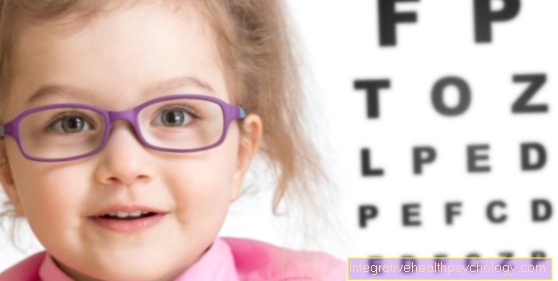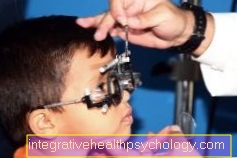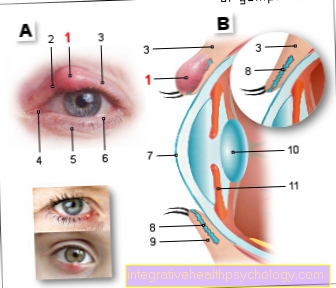Farsightedness in children
Synonyms:
Hyperopia

causes
When the eye smaller than normal is built (Axis hyperopia) or the breaking media (lens, Cornea) a flatter curvature to have (Refractive hyperopia), vision is close only possible blurred. It is usually easier to see in the distance.
Farsightedness so is in most cases innate and due to the abnormal structure of the eye.
Special feature in children
The growth of the Eyeball has on the Farsightedness significant influence in children. Most of the children are in preschool slightly farsighted, but have no complaints with it. Over time and the general growth of the body and eyes This poor eyesight grows but off and normalizes.
Should farsightedness persist in children and they Complaints such as headache, tired eyes, Lack of concentration, bad at reading and writing, double vision or Squint developed, but glasses are recommended.
Farsightedness can be compensated for by accommodation of the eye (exertion of the inner eye muscles and thus an increase in refractive power) and therefore often remains undetected for a long time. Children in particular have a very good ability to accommodate, which is why particular attention must be paid here to whether they might be farsighted if they show symptoms.
Read more on the topic: Visual disturbances in children
In addition, children can get through imbalanced farsightedness Children begin to squint as they are using their ametropia Exercise on the internal muscles of the eye compensate. The reason for the following Internal strabismus lies in the Coupling of accommodation with the Convergence. That means when the inner eye muscles tense to see will perform this automatically an inward rotation through, i.e. there is a squint to the nose.
If a child squinted to compensate for their farsightedness, they may have a weak eyesight as well disturbed spatial vision develop. Hence, a farsighted child should be at the latest then a glasses get prescribed as soon as the farsightedness over +2.5 or +3.0 Diopters increases. The glasses will be with children then usually somewhat weaker prescribed.
The development of the eyes (Visual acuity, spatial vision) is thus supported as a whole, what particularly important is because this development in the later age not made up can be. A Farsightedness in children normally decreases significantly as the eyeball grows in the first few years of life. How long your child should wear glasses, however, can only tell regular approximately annual measurements to be established. Visual acuity checks are often required more often.
diagnosis

A far-sighted person always tenses his inner eye muscles to see, so that they have to be temporarily relaxed in order to be able to make a correct diagnosis of the degree of ametropia.
For this purpose, eye drops are placed in the eye by the ophthalmologist. The drops (also Mydriatic called,) also dilate the pupil at the same time, so that the ophthalmologist can also check the fundus of the child's eye (the retina) very well.
It is important that the drops take effect for at least 30 minutes. Therefore, enough time should be planned for the appointment and an accompanying person should be organized for the way back if possible.
Read more about this under Recognizing poor eyesight in children - does my child see correctly?
therapy
Farsightedness in children is usually corrected with a glasses. It becomes a physical "Converging lens' (Plus lens in plus diopters) used, which has a sharp image on the Retina enables. These glasses are also suitable for people with severe farsightedness not so thick anymore like in old times, but thinner, lighter and therefore more comfortable to wear thanks to a special cut.
In adults: If you have pronounced farsightedness, your vision is reduced when using contact lenses significantly better than with glasses (no restriction of peripheral vision, i.e. the field of vision), so the Contact lens preferred are given. By Laser surgery (refractive surgery) has been able to achieve more relaxed and better vision for some years now, even with farsightedness.
























.jpg)



